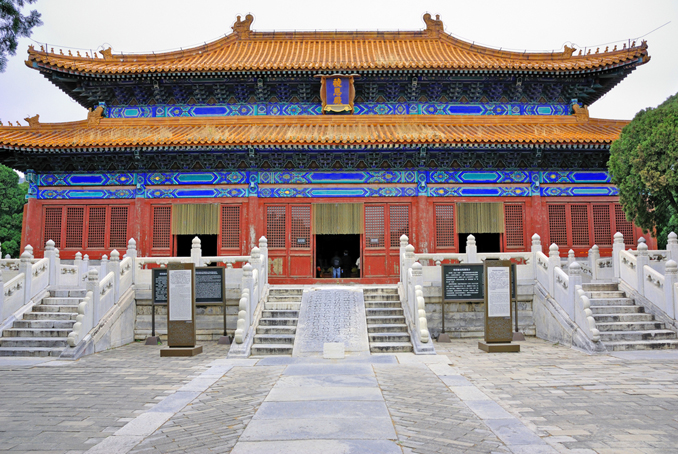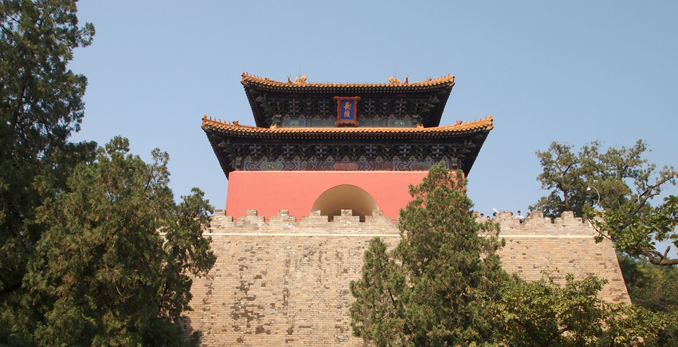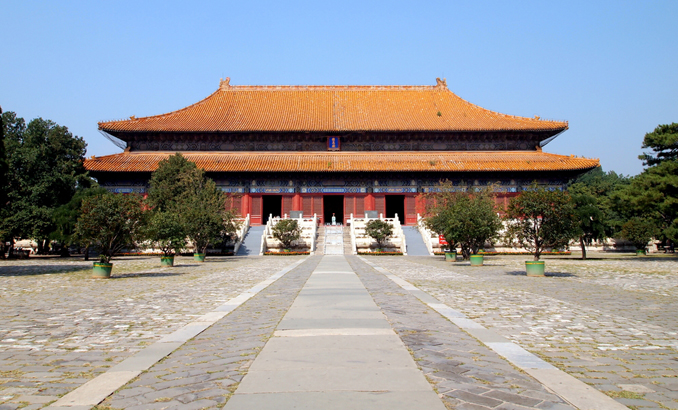
Written by: Li Xianyao
Posted on: December 26, 2014 |  | 中文
| 中文
From the enthronement of the first Chinese emperor in 221 BC to the dethronement of the last emperor in 1911 CE, all dynasties advocated luxurious burials to demonstrate filial duties to the deceased emperors. It was widely believed that emperors used their mausoleums as palaces after they died. Hence, the imperial mausoleums were large in size and had an imposing look?
In 2002, the Xianling Tomb of the Ming Dynasty (1368—1 644) and the east and west imperial tombs of the Qing Dynasty (1644—1911) were inscribed on the UNESCO’s List of World Cultural Heritage?
Most imperial mausoleums are divided into two parts; one is on the ground and the other is underground. The latter is actually an underground palace built with stone to accommodate the remains of the emperor, along with his possessions. Structures on the ground include the Divine Road leading to the tomb, the mausoleum gate, palace halls, a stone tablet dedicated to the dead emperor, and an array of human and animal statues supposedly serving as the dead emperor’s guard of honor. The grandeur and magnificence of imperial mausoleums exemplifies the supremacy of the Chinese sovereign?
The ancient Chinese followed Feng Shui, believing that the location of a tomb influences the future of later generations. Feng Shui embraces the idea of harmony between man and nature, which is a source of inspiration for architects and designers.
The Xianling Tomb is on the suburbs of Zhongxiang City, Hubei Province, Central China. The parents of Emperor Jiajing of the Ming Dynasty were buried together in the tomb, which has green mountains at its back and a river flowing at its front, giving it perfect geomantic omens. Structures in the mausoleum are arranged neatly at different heights on the slope of a hill. They are in perfect harmony with the mountains and rivers of the area. This tomb is equally magnificent as the other imperial mausoleums, even though its occupant was never an emperor himself.
 |
In 1521, Emperor Wuzong, the tenth of the Ming Dynasty, died without a son. Hence, one of his nephews was chosen to succeed him. The new emperor’s dead father was a prince who had not been provided a luxurious tomb. Despite opposition from his court officials, Emperor Jiajing honored his dead father by having his tomb renovated to match the standards of other emperors’ tombs. Although it resembles an imperial tomb in size, decoration and layout, Xianling is still very unique. The Divine Road in front of the tomb is wound up like the Chinese dragon, and the surrounding walls form the shape of a gourd-like bottle.
The Qing Dynasty (1644 - 1911) was China’s last feudal dynasty. It had two imperial burial sites, about 100 kilometers east and west of the capital, Beijing.
Qing Dynasty Emperors were very particular about their burial sites, carefully investigating their geological, hydrological and climatic conditions. They always ensured that the tomb structures were in perfect harmony with the surroundings. A queen who died before the emperor was to be buried with her husband in the same imperial tomb. Conversely, a queen who outlived the emperor had a separate, smaller tomb built near the emperor’s tomb.
The east imperial burial ground in Zunhua County, Hebei Province, North China has fifteen tombs: five for emperors, four for queens, five for imperial concubines, and one for the princess. The emperor is buried in the center, with the queen close by, and his concubines, farther away?
Emperor Shunzhi (1638 – 1661) was the second emperor of the Qing Dynasty and the first to rule China after the Ming Dynasty was overturned in 1644. His tomb, Xiaoling, is along the axis of the east imperial burial site, while the tombs of the other four emperors are placed in order of seniority. This symbolized that the junior emperors were performing their filial duties to their ancestors. The divine roads in front of the tombs of the emperors and their queens are always connected. Moreover, the divine road of Emperor Shunzhi’s tomb is connected to the divine roads of the four emperors that succeeded him. This road system was meant to show that the imperial family is eternal?
The following is a brief account of the tombs of four other Qing emperors at the east imperial burial site:
 |
The Jingling Mausoleum is occupied by Emperor Kangxi (1654 – 1722), son of Emperor Shunzhi, who reigned over China for 61 years; longer than any other emperor of the dynasty. Emperor Kangxi had to his credit the last period of national prosperity in China’s feudal society?
The Yuling Mausoleum is where Emperor Qianlong (1711 – 1799) is buried. He ruled China for 60 years before stepping down in favor of his son, and then held the title of “super emperor” for three years. A devoted Buddhist, he had many relieves on Buddhist themes carved in his underground palace.
The Dingling Mausoleum belongs to Emperor Xianfeng (1831 – 1861), who reigned for only 11 years. China was facing domestic troubles and foreign invasion during his reign. A lot of old material had to be used to construct his tomb due to exhaustion of the national treasury, and his tomb could not match the quality of the previous emperors’ tombs.
Emperor Tongzhi (1856 – 1874), the only son of Empress Dowager Cixi (1835 – 1908), was buried in the Huiling Mausoleum. He died at 19, and was the shortest-lived Qing dynasty emperor. His tomb was constructed in haste as China was facing financial difficulties at the time. As a result, the wood structure of the ground palace decayed in just 21 years, and had to be torn apart and reconstructed.
The Zhaoxiling Mausoleum belongs to Empress Dowager Xiaozhuang, mother of Emperor Shunzhi and grandmother of Emperor Kangxi. She assisted the two successive emperors in governing the country. Historians concur that Empress dowager was an outstanding stateswoman of the early Qing Dynasty.
Empress Dowager Cixi, China’s de facto ruler for 48 years, is also buried at the east imperial burial site. Her mausoleum is known as “Dingdong”. Empress Dowager Cixi was originally an imperial concubine of Emperor Xianfeng. After his death, she came into power through a coup. She was dissatisfied with the ground palace of her tomb, and had it rebuilt. The finest materials were used in reconstruction, making the ground palace the most luxurious imperial burial structure of the Ming and Qing dynasties.
 |
According to burial rules, a son must be buried beside his father. However, Emperor Yongzheng, who succeeded Emperor Kangxi, held that the east imperial site was not favorable in terms of feng shui. He chose a separate site for himself, which would become the west imperial burial site in Yixian County, Hebei Province. His son, Emperor Qianlong, was supposed to have his tomb built at the same site. However, he believed that if successive emperors were buried at the west imperial site, the east site would eventually be deserted. Hence, he had himself buried at the east site. Furthermore, he established a rule for subsequent emperors that fathers and sons would be buried on opposite sides.
The Tailing Mausoleum, belonging to Emperor Yongzheng, was built in 1730. It was the first tomb at the west imperial burial site, and its layout, size and shape met all the geomantic requirements.
The Changling Mausoleum is occupied by Emperor Jiaqing, son of Emperor Qianlon. It is similar in size to the Tailing Mausoleum.
Emperor Daoguang occupies the Muling Mausoleum, built in 1831. The country faced financial difficulties at the time. Hence, Emperor Daoguang cancelled the building of some structures in his mausoleum.
Finally, the Chongling Mausoleum is occupied by Emperor Guangxu. It was built in 1909, and was the last imperial tomb built in China.
You may also like: